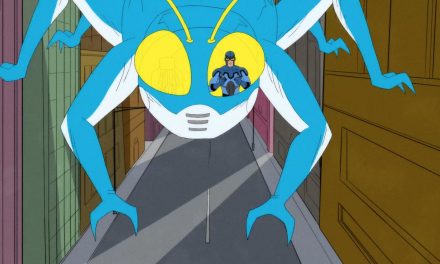At first glance, Netflix’s Life on Our Planet looks like an action film wearing Walking with Dinosaurs as a disguise. The official trailers and even the first episode makes it seem like so. However, looks are deceiving here. We instead get a perfectly decent dinosaur and other assorted prehistoric creature documentary in which they’re both silly and cute, with just enough action, drama, and epicness sprinkled in for flavor. If you want a more epic version of Apple TV+‘s Prehistoric Planet that covers more of Earth’s timeline, then this is the nature documentary for you.
Life on Our Planet: Details

Life on Our Planet is an upcoming streaming nature documentary from Netflix. Silverback Films (subsidiary of All3Media) and Amblin Television (Resident Alien, Halo, Gremlins: Secrets of the Mogwai) are the production companies behind this nature documentary.
Life on Our Planet features Steven Spielberg (E.T. The Extra-Terrestrial, Jurassic Park, Saving Private Ryan) himself as an executive director alongside Alastair Fothergill (The Blue Planet, Planet Earth), Keith Scholey, Darryl Frank, and Justin Falvey. Lorne Balfe is the composer behind all the epic music you hear in this nature documentary.
Voice Cast
In terms of voice acting for Life on Our Planet, we have only Morgan Freeman (The Dark Knight Trilogy, March of the Penguins, Our Universe) as the narrator.
When and Where to Watch
Life on Our Planet will make its debut on October 25, 2023. This nature documentary will run for a grand total of 8 episodes, each roughly an hour long. As you might expect, you can watch this nature documentary only on Netflix.
Life on Our Planet: Logline
Normally, this part would be where I give you all a spoiler-filled plot summary of Life on Our Planet. However, this is the pre-release version of my usual reviews. Thus, you get the spoiler-free version along with the official logline from Netflix. You can check that out below:
This is the story of life’s epic battle to conquer and survive on planet Earth. Today there are 20 million species on our planet, yet what we see is just a snapshot in time — 99% of earth’s inhabitants are lost to our deep past. The story of what happened to these dynasties — their rise and their fall – is truly remarkable. In partnership with Industrial Light & Magic, the series uses the latest technology and science to bring long extinct creatures back to life, Life on Our Planet reveals the incredible story of life on our planet.
Life on Our Planet: The Good

Without question, the best parts of Life on Our Planet are the visuals. Epic, impressive, or jaw-dropping; whichever word you want to use to describe this nature documentary, it’s all of the above. To start with, let’s talk about the CGI prehistoric creatures. As you can see from the screenshot above and even in the key arts, Silverback Films and Amblin Television truly spared no expense for the CGI. From the CGI prehistoric critters like the Anadaspis and the Cameroceras above, to the CGI images of planet Earth from orbit when mass extinctions and other geologically significant events are happening, this nature documentary is right on par with Prehistoric Planet in terms of CGI quality. The only difference is in the sheer scope of Netflix’s nature documentary for their CGI. As well as the fact that this nature documentary covers all of Earth’s eras rather than just the Mesozoic.
However, the CGI can’t take all the credit for the amazing visuals of Life on Our Planet. This nature documentary also features extensive live-action footage of present-day nature. At least 30-50% of each episode consists of very close-up and ultra-high-definition of real-life animals being animals. You might ask why present-day animals would be in a nature documentary about prehistoric ones. Well, since we clearly do not have live dinosaurs and other prehistoric critters to study, we can only guess at their behavior. And we can only guess their behavior by looking at those real-life animals.
Last but not least, we have Morgan Freeman as the narrator of Life on Our Planet. Yes, I know this may seem like a small thing, but it’s significant. A nature documentary’s narrator can make or break it. Just listen to David Attenborough’s voice in Prehistoric Planet as proof of that. Morgan Freeman’s voice may be much different from Attenborough’s, but he does still have a calm and stable voice. Deep too. It’s why we love Freeman’s voice for these documentaries.
Life on Our Planet: The Bad

The part that may be a turn-off for fans of Prehistoric Planet is the lack of fluffy and/or baby dinosaurs in Life on Our Planet. At least, at first. It takes a while for them to appear, but they do appear. Alongside prehistoric and even modern day anbimals being silly. This may be a case of “Your Mileage May Vary“, but I believe that a good nature documentary should feature animals being animals. Sometimes, or even much of the time, animals are silly buggers. This Netflix nature documentary does a good job in capturing that despite what the official trailers or even Ep. 1 would tell you.
And really, those official Netflix trailers and Ep. 1 do a poor job of giving audiences an idea of what Life on Our Planet is about. They make this nature documentary seem like an action-packed drama and nothing but. While a little action and drama in a nature documentary is fine, I believe that they shouldn’t the only things there. Again, your mileage may vary here.

![Life On Our Planet: A Prehistoric Epic Disguised As An Action Movie [Review]](https://www.thathashtagshow.com/wp-content/uploads/2023/10/395116224_267459396281720_6299615963118761734_n-1200x640.jpg)
![Sneakerella – A Fun Twist On An Old Tale [Review]](https://www.thathashtagshow.com/wp-content/uploads/2022/05/project_20220511_1039428-01-440x264.png)


